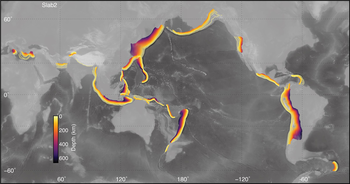Subduction
In the framework of plate tectonics, subduction is the process of sinking of a lithospheric plate under the edge of another plate, forming the so-called convergent boundaries between plates. The subducted plate, the one that sinks, is usually formed by oceanic crust, thinner and denser than the continental one. Subduction occurs along wide subduction zones that are currently especially concentrated in the Pacific Ocean environment, in the so-called Pacific ring of fire, but there are also subduction zones in parts of the Mediterranean Sea, the Antilles, the South Antilles and the Indian coast of Indonesia.
Subduction is caused by two tectonic forces, one that comes from the push of the mid-oceanic ridges and another that derives from the forces that pull on the blocks.
Subduction causes many large earthquakes which originate in the Benioff zone. Subduction also causes the partial melting of part of the Earth's mantle, generating magma that rises, giving rise to plutonic intrusions and volcanoes.
The angle of subduction, the angle that the plane of the Benioff zone makes with the Earth's surface, can vary from about 90° in the Marianas to as little as 10° in Peru.
The oceanic crust that is on its way to being subducted in the Mariana Trench is the oldest oceanic crust on Earth without counting ophiolites. Steeper subduction is associated with greater back-arc extension, causing crustal migration from the volcanic arcs and fragments of continental crust, leaving behind a marginal sea.
Forces promoting subduction
Several factors must be taken into account when studying the dynamics of subduction.
Push force
The buoyant force is the main cause of subduction; It is generated by the action of interplate constructive boundaries (oceanic ridges). The force generated by the push of the young rocks in the ridges leads the older rocks (furthest away from the ridge) to collide with the continental crust and likewise the continental plate generates a force opposite to the oceanic plate.
Gravitational Forces
One of the main factors that favors subduction is the difference in gravitational forces, due to the different density of the plates. Buoyancy, which depends directly on it, is opposite to the direction of the gravitational force; therefore, the greater the gravitational force, the lower the buoyancy. In general, the oceanic crust is denser than the continental one, due to its chemical composition. The oceanic crust, made up of basic and ultrabasic rocks such as gabbros, dunites and basalts (rocks rich in iron, magnesium, chromium and different heavy elements), is much heavier than the continental crust, made up of intermediate and acid rocks such as andesites, granites and rhyolites (rocks rich in sodium, potassium and aluminum).
Not all convergent margins are subduction zones: if the density between the two plates is very similar, instead of subduction there will be obduction.
The angle of subduction
The angle of subduction will depend a lot on the characteristics of the subducting crust and will generate different characteristics at the surface. It could be said that a normal angle of subduction is 30 degrees (very similar to that of Chile-type subduction), but when this angle varies we will have:
High Subduction Angles
High angles of subduction, up to even 90 degrees in some parts of the world, will create very specific surface conditions. The best example is the collision between the Pacific plate and the Philippine plate. Here the speed of descent is greater than the horizontal speed generated by the thrust; this causes the Pacific plate to recede generating a force in the opposite direction to the direction of the thrust generated by the ridge. This generates a back-arc basin, a distensive environment that is what causes subduction between the Philippine plate and the Eurasian plate. The active boundary just in this zone of high subduction angle takes on a convex shape; This means that we can define the shape of the boundary to predict the angle of subduction (for example, the subduction between the Scottish and South American plates). In these areas it is possible to distinguish remaining arches.
Low angles of subduction
Low subduction angles are caused by bulges in the subducting plate, such as those between the Nazca plate and the South American plate. The oceanic ridges in the first, formed by former hot spots now inactive, are subducted and cause the subduction angle to decrease in a certain part of the active boundary. The low subduction angles cause the thickening of the magmatic arc, as occurs in the Central Andes, leading to the generation of highlands (such as the Andean highlands).
Seismicity and volcanism in subduction zones
The friction generated by the contact and movement between plates generates an accumulation of elastic potential energy, which is released in the form of relative movements between two blocks separated by a plane (faults). The convergent margins are the areas of greatest seismic activity in the world. If the seismic activity between convergent limits is mapped, the Wadati-Benioff zone will be obtained, which is the one that directly defines the surface amplitude of subduction action. Earthquakes due to subduction intensely affect countries such as Japan, Chile, Haiti and regions such as northeastern Russia.
Volcanoes that have their genesis in subduction zones are very large and steep, due to the composition of the magma that rises and causes violent eruptions due to the viscosity of the lava. When delineating volcanoes with these characteristics on a world map, very clear lines are found that are parallel to the mountain ranges; that is, a subduction zone can be defined by the volcanism present. This volcanism is very different from intra-plate volcanism, whose conditions and characteristics are very different: more fluid lavas, with a basic composition, and very extensive volcanoes with very gentle slopes, such as those in Hawaii.
Contenido relacionado
Piedmont glacier
Gabbro
Triassic

